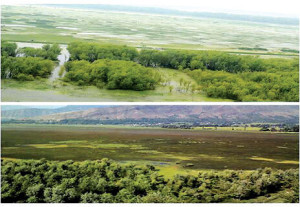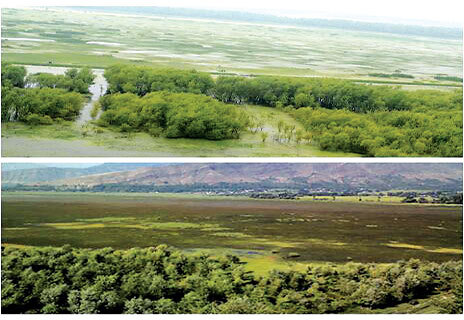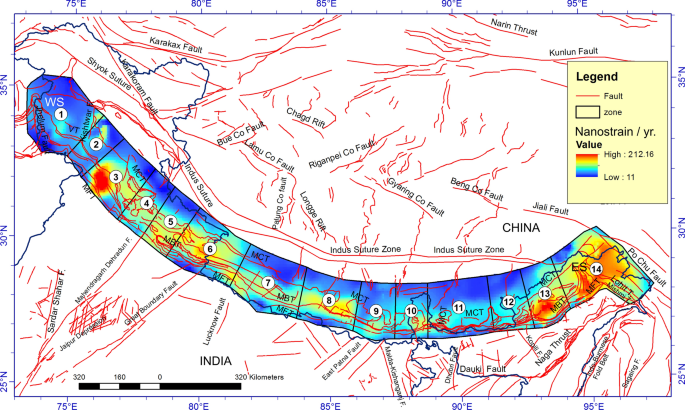One of the largest freshwater lakes in Asia, Wular Lake has shrunk to nearly half its original area in the last few decades due to administrative apathy, extensive pollution, siltation and encroachment. The lake in north Kashmir’s Bandipora district is dying a silent death.
 The lake faces environmental threats including the conversion of large parts of catchment areas into agriculture land, siltation, rampant willow plantation, encroachment, untreated sewage, solid waste and weed infestation.
The lake faces environmental threats including the conversion of large parts of catchment areas into agriculture land, siltation, rampant willow plantation, encroachment, untreated sewage, solid waste and weed infestation.
Wular covered an area of 217.8 sq km which included 58 sq km of associated marshes in 1911. The area was reduced to 86.71 sq km from 1911 to 2007. But as per the State’s 2013 revenue records, the lake’s area has shrunk to 75 sq km.
“Overall there has been reduction of the lake area by 45% mainly due to conversion for agriculture (28%) and plantation (17%). Further associated marshes were reduced by 70% again due to conversions for agriculture and settlements,” said AjazRasool, hydraulic engineer and one of the expert members of the Comprehensive Management Action Plan (CMAP) on Wular Lake.
He said that one fifth of the water holding capacity has been lost over last three decades due to siltation from catchments and wetland conversions for agriculture and willow plantations.
“Wular acts as efficient basin for floodwaters, maintaining a balance in the hydrographic system in the Valley, therefore plays a significant role in water security in the Kashmir valley by regulating the release of floodwaters. For decades this role had gone unnoticed,” Rasool said.
He said that direct discharge of solid and liquid wastes from the settlements all along River Jhelum mainly from Srinagar city and other towns in the upstream area have led to degradation of water quality and health hazards to the communities living around the Wular Lake.
“Earlier dredging in the downstream reaches of River Jhelum (Sopore to Baramulla) during 1960-86 was carried out to enhance water outflows and reduce flooding risk to the major upstream settlements, particularly Srinagar city. But in 1986 dredging was stopped due to lack of machinery and manpower, which led to accumulation of silt in the lake, thereby reducing its water holding capacity,” he said.
The lake water spread undergoes a significant fluctuation between the summer and winter months. “The total water holding capacity of the Wular at normal lake levels (1576 meters) is 340 Mcum. The storage available between the average winter levels and summer levels is of about 170 mcm,” Rasool said, adding that the average area has been estimated as 54 sq km, which declines to 24 sq km during the lean period and increases to 89 sq km during summer months.
Rasool said that a comparison of the stage volume relationship derived for the Ningli Barrage project indicates a loss of 91.56 mcm of capacity during last 30 years. “Thus about one fifth of the water holding capacity has been lost over the last three decades.”
He said that this is quite evident through remote sensing survey studies which indicate northward shifting of course of River Jhelum after Baniyari due to heavy silt accumulation at the inlet.
Given the huge biodiversity values, the lake was declared a Ramsar site (wetland of international importance) in 1990. But the conservation process started only in 2011 when the Centre agreed to release Rs 120 crore in four installments for conservation and restoration of Wular.
Rasool said that Comprehensive Management Action Plan (CMAP) was conceived by Wetlands International South Asia which is now under implementation by the Government of Jammu and Kashmir under Wular Conservation and Management Authority (WUCMA) to address the degradation and regain water holding capacity of the lake.
“But unfortunately the progress of the project undertaken by WUCMA is very slow, if the lake is to be restored to its original glory, the project work needs to be accelerated by WUCMA,” he said.
DFO Bandipora, IrfanRasool, said that forest department has so for removed 26889 willows from various compartments of the lake. “The task of removing willows is part of the Wular project under the supervision of WUCMA to restore water navigation in the lake.”
He also said that there are 24 lakh willows under an area of 3772 hectares of the lake. “It is a huge task. All the willows cannot be removed in one go because there are apprehensions of encroachments in the areas from where willows would be removed,” he said adding that the removing willows is carried out in a phased manner.”






